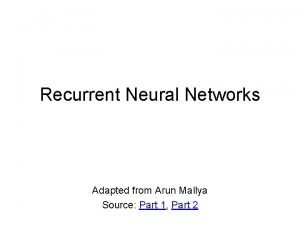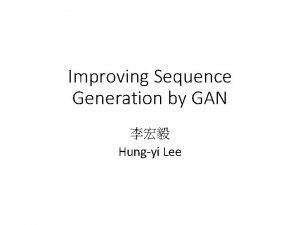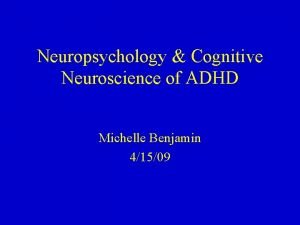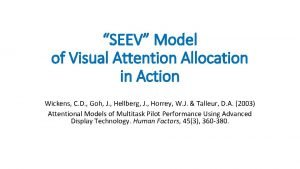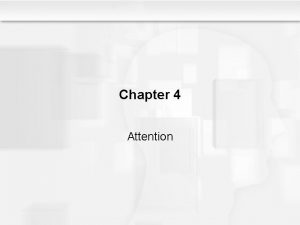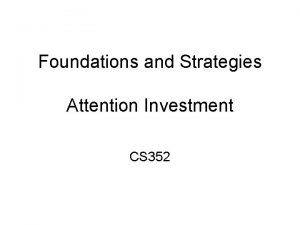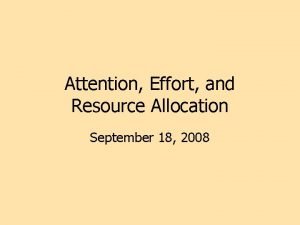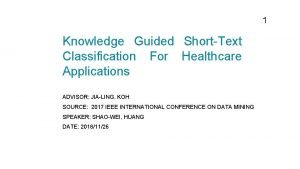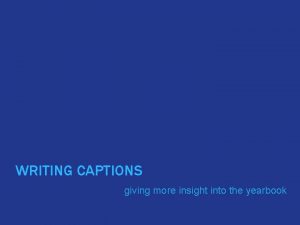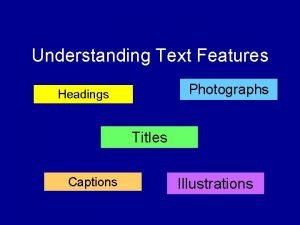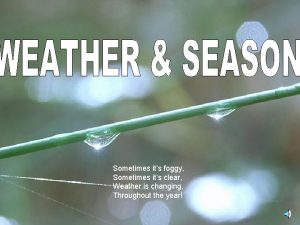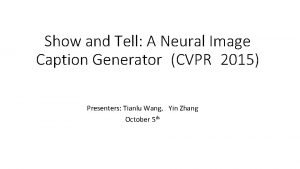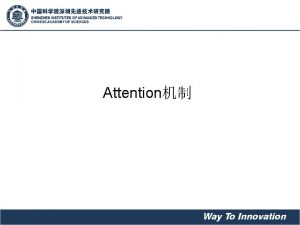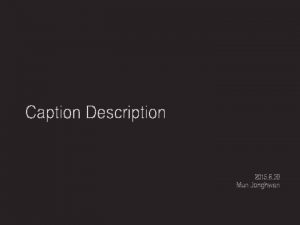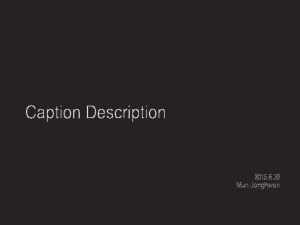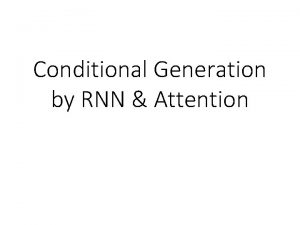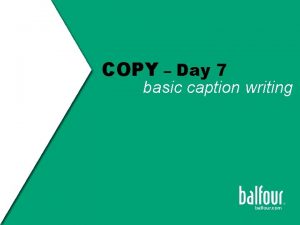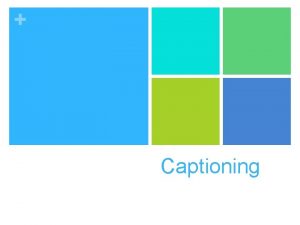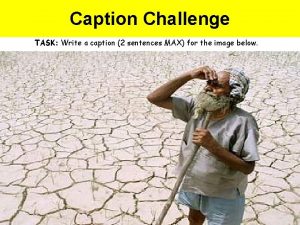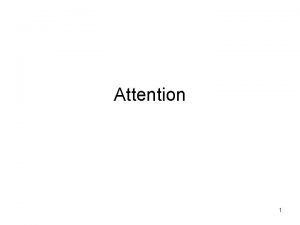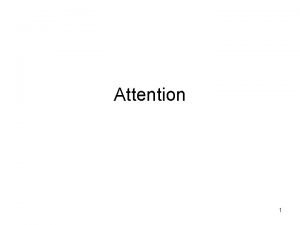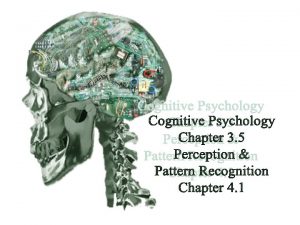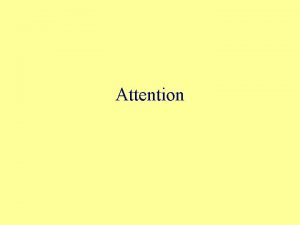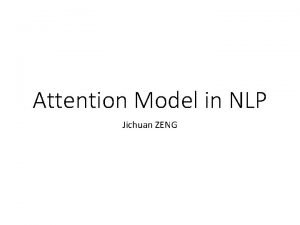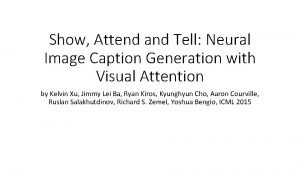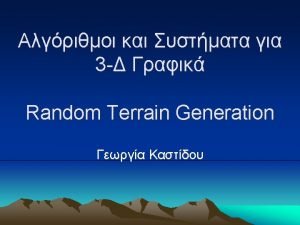Caption Generation with Attention Model 2015 11 17


![Existing Methods Using detectors Using neural network • Embedding[farhadi 10] • Encoder-Decoder[Vinyals 15] • Existing Methods Using detectors Using neural network • Embedding[farhadi 10] • Encoder-Decoder[Vinyals 15] •](https://slidetodoc.com/presentation_image_h2/487e3c5487a4170007bc8784bd8fb7a2/image-3.jpg)














- Slides: 17

Caption Generation with Attention Model 2015. 11. 17 Jonghwan Mun

Caption Generation • Identifying not only objects and scene but activity and relationship and then generating coherent sentence – Input: Image – Output: sentence (sequence of words)
![Existing Methods Using detectors Using neural network Embeddingfarhadi 10 EncoderDecoderVinyals 15 Existing Methods Using detectors Using neural network • Embedding[farhadi 10] • Encoder-Decoder[Vinyals 15] •](https://slidetodoc.com/presentation_image_h2/487e3c5487a4170007bc8784bd8fb7a2/image-3.jpg)
Existing Methods Using detectors Using neural network • Embedding[farhadi 10] • Encoder-Decoder[Vinyals 15] • Fill the pre-defined template[Kulkarni 11] • Attention model[Xu 15] L S T M

Attention Model • Select feature relevant to word at every step man is standing <EOS> <INIT> rnn Attention <BOS> rnn Attention man Attention is standing

Two Types of Attention Model • Soft attention model (deterministic) – Calculate relevancy of each feature for next word – Context is weighted sum of features Soft Attention • Hard attention model (stochastic) – Select only one feature Hard Attention

Soft Attention Model • LSTM attention

Hard Attention Model • LSTM attention sampling

Reinforce Learning • Input Directly backpropagation impossible Sampling by f() Output Loss Directly backpropagation possible

Attention model with MIL • Finetuning VGG-net with MIL • Using fc 7 (12, 4096) as features for attention model 1 0 Query Image (565 x 565) Fully Convolutional Network Spatial Word Response Map (12, 1000) Word Score Vector (1, 1, 1000)

Experiment Result BLEU-1 CIDEr Conv 5 Fc 7 -all Fc 7 -topk-word 65. 7 67. 5 68. 5 81. 9 85. 9 • Training on full train data and additional 30, 000 validation data • Test on 5, 000 validation data

Current Research Direction • Hierarchical attention model – First, select between high-level and low-level layer (hard attention) – Second, attend to region related to word (soft attention) man <INIT> RNN Select Attention Features Select Feature level RNN Attention is Attention <EOS> RNN Attention man Attention standing RNN Attention <BOS> Attention is standing Attention

Experiment Result BLEU-1 Conv 5 Fc 7 -all Fc 7 -sample Hierarchical 61. 9 65. 4 64. 6 64. 7 • Training on 5, 000 validation data • Test on different 5, 000 validation data • Hierarchical is soft-soft attention model

Discussion • Using high-level feature is better • Redundant features makes worse • Learning hierarchical attention is hard

Plan • RCNN + attention model man is standing <INIT> rnn Attention <BOS> RCNN rnn Attention man Attention is standing

Plan • RCNN + phrase-based attention model • Two LSTM – one for sentence and another for phrase a man sitting with a dog P-LSTM S-LSTM attention RCNN

Reference

Reference
 Arun mallya
Arun mallya Caption generation
Caption generation Alternating attention vs divided attention
Alternating attention vs divided attention Second generation vs first generation antipsychotics
Second generation vs first generation antipsychotics You are good and your mercy is forever
You are good and your mercy is forever Seev model of attention
Seev model of attention Condition attention question addition
Condition attention question addition Early selective attention
Early selective attention An attention investment model
An attention investment model Wickens
Wickens Attention model
Attention model Yearbook caption examples
Yearbook caption examples Multimedia video
Multimedia video Illustrations text features
Illustrations text features Foggy weather quotes
Foggy weather quotes Show and tell: a neural image caption generator
Show and tell: a neural image caption generator Tiga anak kecil dengan langkah malu-malu
Tiga anak kecil dengan langkah malu-malu Case caption example
Case caption example
